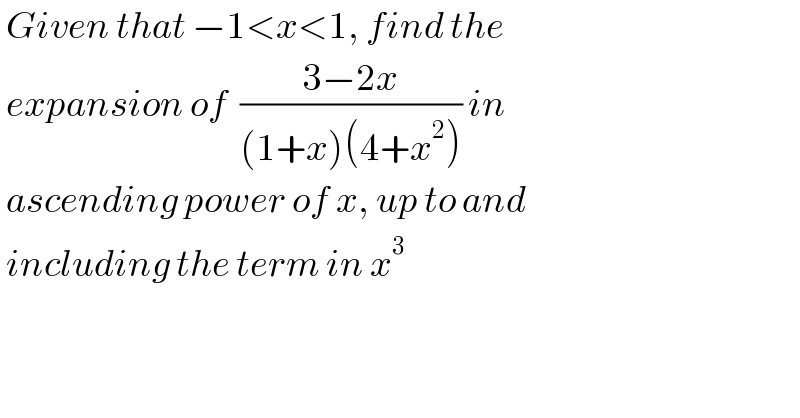
Question and Answers Forum
Question Number 161823 by MathsFan last updated on 22/Dec/21

Answered by mr W last updated on 23/Dec/21
![=((3(1−((2x)/3)))/(4(1+x)(1+(x^2 /4)))) =(3/4)(1−((2x)/3))(1−x+x^2 −x^3 +x^4 −...)(1−(x^2 /4)+(x^4 /(16))−...) =(3/4)[1+(−(2/3)−1)x+(1−(1/4)+(2/3))x^2 +(−1−(2/3)+(2/(3×4))+(1/4))x^3 +...] =(3/4)[1−(5/3)x+((17)/(12))x^2 −(5/4)x^3 +...] =(3/4)−(5/4)x+((17)/(16))x^2 −((15)/(16))x^3 +...](Q161828.png)
Commented bypeter frank last updated on 23/Dec/21

| ||
Question and Answers Forum | ||
Question Number 161823 by MathsFan last updated on 22/Dec/21 | ||
 | ||
Answered by mr W last updated on 23/Dec/21 | ||
![=((3(1−((2x)/3)))/(4(1+x)(1+(x^2 /4)))) =(3/4)(1−((2x)/3))(1−x+x^2 −x^3 +x^4 −...)(1−(x^2 /4)+(x^4 /(16))−...) =(3/4)[1+(−(2/3)−1)x+(1−(1/4)+(2/3))x^2 +(−1−(2/3)+(2/(3×4))+(1/4))x^3 +...] =(3/4)[1−(5/3)x+((17)/(12))x^2 −(5/4)x^3 +...] =(3/4)−(5/4)x+((17)/(16))x^2 −((15)/(16))x^3 +...](Q161828.png) | ||
| ||
Commented bypeter frank last updated on 23/Dec/21 | ||
 | ||